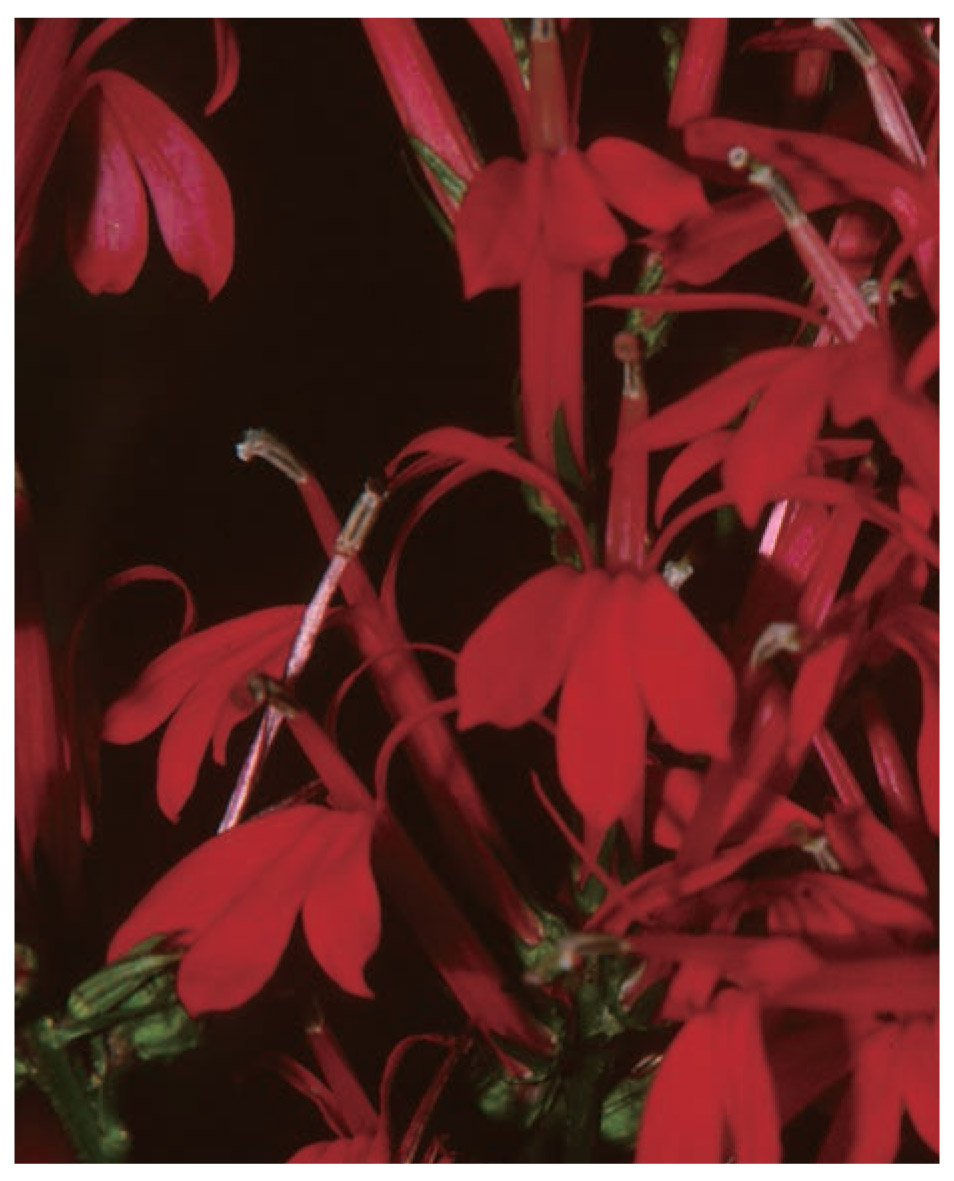

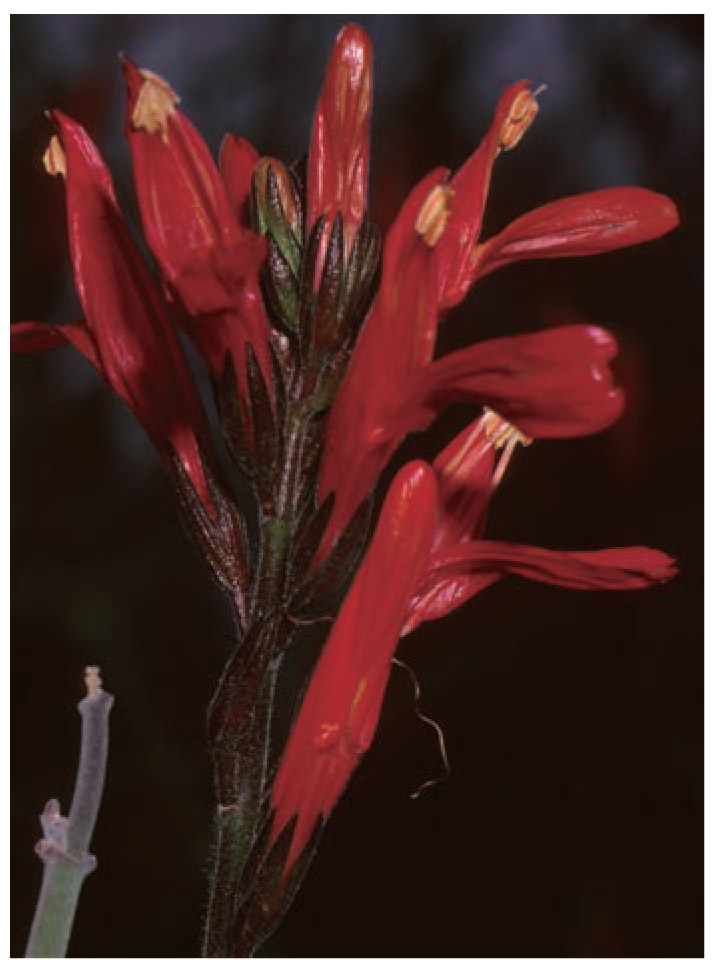
CHUPAROSA
Beloperone
Justicia californica
Acanthus Family (Acanthaceae)
Height: To 6’.
Flowers: Dull red, tubular; 2-lobed upper and 3-lobed lower lip; anther with large, white point at tip; to 2” long, in terminal clusters; followed by 2-celled capsule.
Leaves: (When present) grayish green, covered with soft hairs; oval to egg-shaped; to 1” long; falling during drought or cold.
Blooms: On and off throughout year.
Elevation: 1,000 to 2,500’.
Habitat: Rocky slopes and along washes.
Comments: Stems are soft and hairy. A favorite with hummingbirds (Chuparosa is Spanish for “hummingbird”). Three species of Justicia in Arizona.
Photograph taken at Usery Mountain Recreation Area, March 7. Distinguished from Red Jacobinia (Justicia candicans) (at right) by terminal clusters of flowers; more narrow tube without prominent white throat markings, and by presence of white point at anther tip.
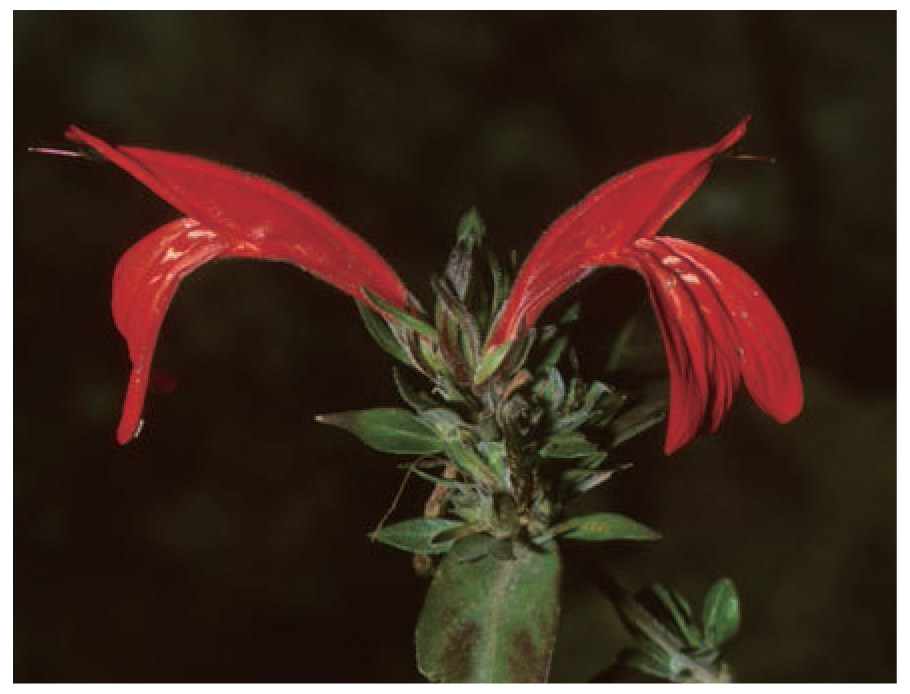
RED JACOBINIA
Justicia candicans (Jacobinia ovata)
Acanthus Family (Acanthaceae)
Height: Sprawling shrub to 5’.
Flowers: Deep red with white markings in throat; tubular, 2-lobed upper and 3-lobed lower tube; petals united for about two-thirds of tube; lower lobes wide, notched, and curving downward; anther lacks large white point at tip; flower to 1½” long, in upper leaf axils; followed by 2-celled capsule.
Leaves: Grayish green with deep purplish brown markings; covered with soft hairs; oval to sharply pointed; to 1½” long, ¾” wide.
Blooms: On and off throughout year.
Elevation: 1,500 to 3,500’.
Habitat: Rocky foothills, washes, and canyons.
Comments: Three species of Justicia in Arizona. Photograph taken below Horse Mesa Dam, Apache Lake, March 23.
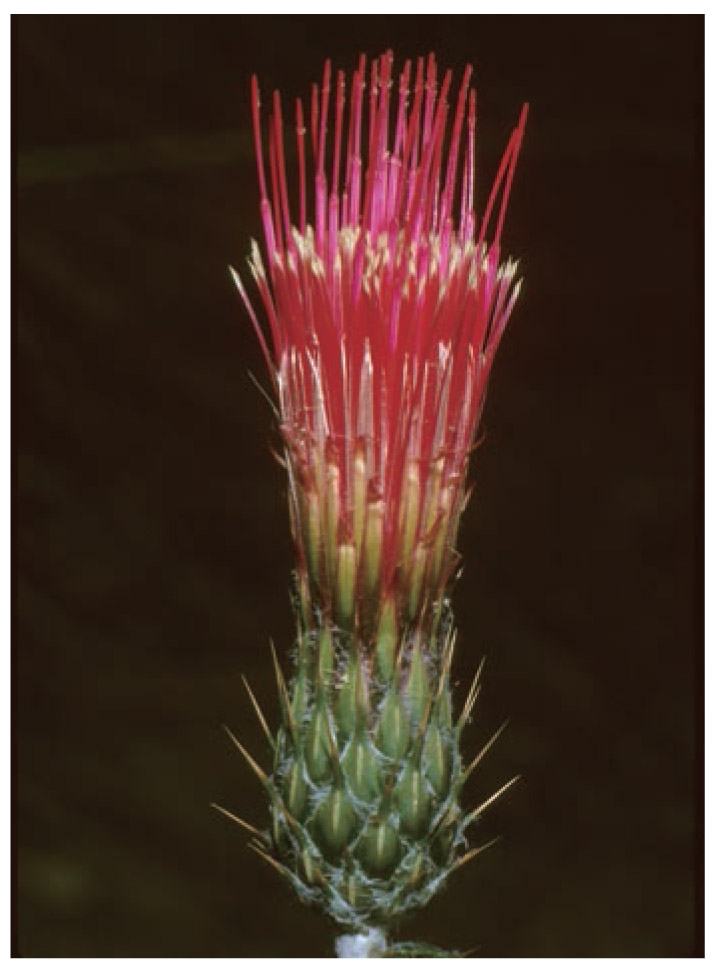
ARIZONA THISTLE
Cirsium arizonicum
Sunflower Family (Asteraceae)
Height: To 4’.
Flowers: Bright red or carmine, with slender flower heads; to 2” long.
Leaves: Grayish green, very hairy, alternate; spinytoothed and tipped; to 2” long.
Blooms: May–October.
Elevation: 3,000 to 7,000’.
Habitat: Roadsides, chaparral, and clearings in ponderosa pine forest.
Comments: Native Americans use thistles medicinally. Around two dozen species of Cirsium in Arizona. Photograph taken at Lynx Lake, October 5.
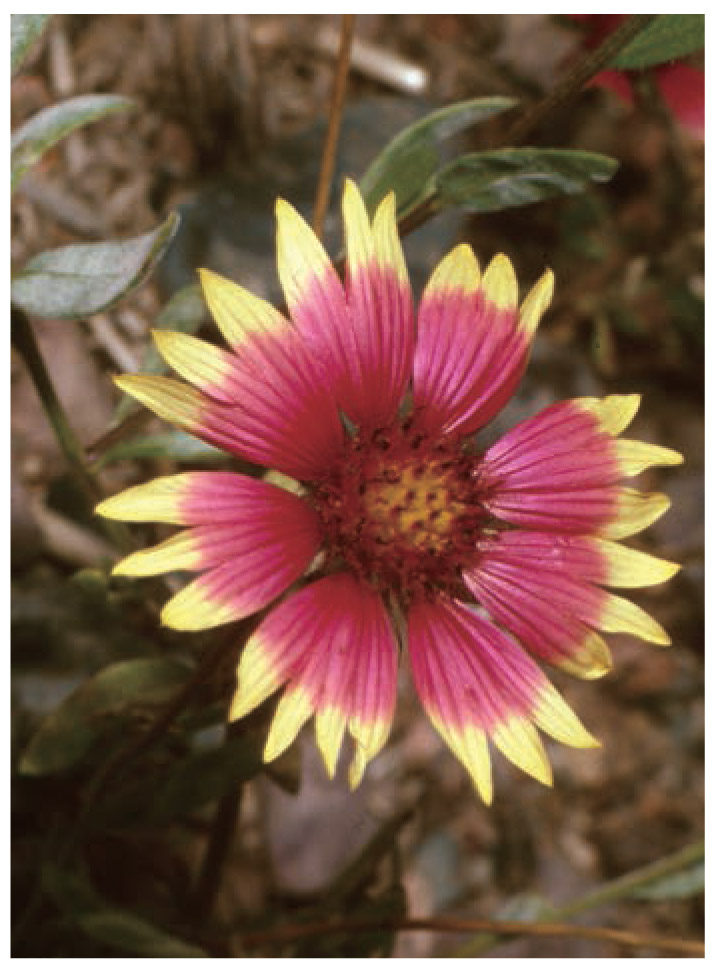
BLANKETFLOWER
Firewheel
Gaillardia pulchella
Sunflower Family (Asteraceae)
Height: To 2’.
Flowers: Reddish purple, wedge-shaped ray flowers tipped with bright yellow; broad ends of rays divided into 3 sharp lobes; reddish purple disk flowers in dome-shaped center; to 3” wide.
Leaves: Green; upper leaves oblong, lower ones lobed; to 3” long.
Blooms: April–September.
Elevation: 3,500 to 5,500’.
Habitat: Roadsides, fields, and clearings in pinyonjuniper woodlands and ponderosa forests.
Comments: Annual. Five species of Gaillardia in Arizona. Photograph taken at Payson, September 12.

CARDINAL FLOWER
Scarlet Lobelia
Lobelia cardinalis
Bellflower Family (Campanulaceae)
Height: To 5’.
Flowers: Bright red, tubular, with 2 small upper lobes, 3 larger lower lobes; stamens united in column; to 1½” long; in elongated cluster on erect stalk.
Leaves: Dark green, oblong, toothed; to 5” long.
Blooms: June–October.
Elevation: 3,000 to 7,500’.
Habitat: Wet areas and along streams.
Comments: Perennial herb. Attracts hummingbirds. Six species of Lobelia in Arizona. Photograph taken in Tucson area, August 23.

ARIZONA HONEYSUCKLE
Madreselva
Lonicera arizonica
Honeysuckle Family (Caprifoliaceae)
Height: A stiff, trailing vine to 3’ or more.
Flowers: Red outside, with orange throat inside; trumpet-shaped; in small, terminal, whorled cluster arising from 2 joined leaves; followed by cluster of red berries.
Leaves: Bluish green above, paler beneath; very finely haired; oval; joined together in pairs; to 2” wide, 2¾” long.
Blooms: June–July.
Elevation: 6,000 to 9,000’.
Habitat: Open coniferous forests.
Comments: Has scaly, brown trunk. A favorite of hummingbirds. Berries eaten by birds and small mammals. Twelve species of Lonicera in Arizona. Photograph taken near Willow Springs Lake, June 11.
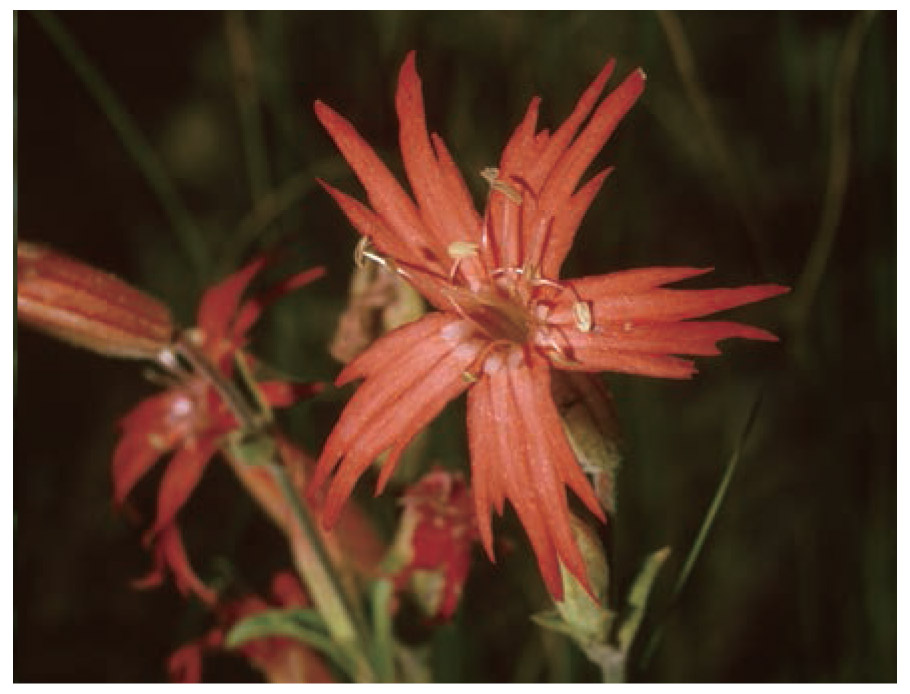
MEXICAN PINK
Mexican Campion
Silene laciniata ssp. greggii
Pink Family (Caryophyllaceae)
Height: To 3’.
Flowers: Cardinal red, with 5 petals, each cut at tips into 4 segments; flower head to 1½” wide.
Leaves: Dark green, narrowly lance-shaped, sticky, and fine-haired; to 6” long.
Blooms: July–October.
Elevation: 5,500 to 9,000’.
Habitat: Coniferous forests.
Comments: Perennial herb. “Pinked” petals give family its name. Nine species of Silene in Arizona. Photograph taken at Greer, September 11.
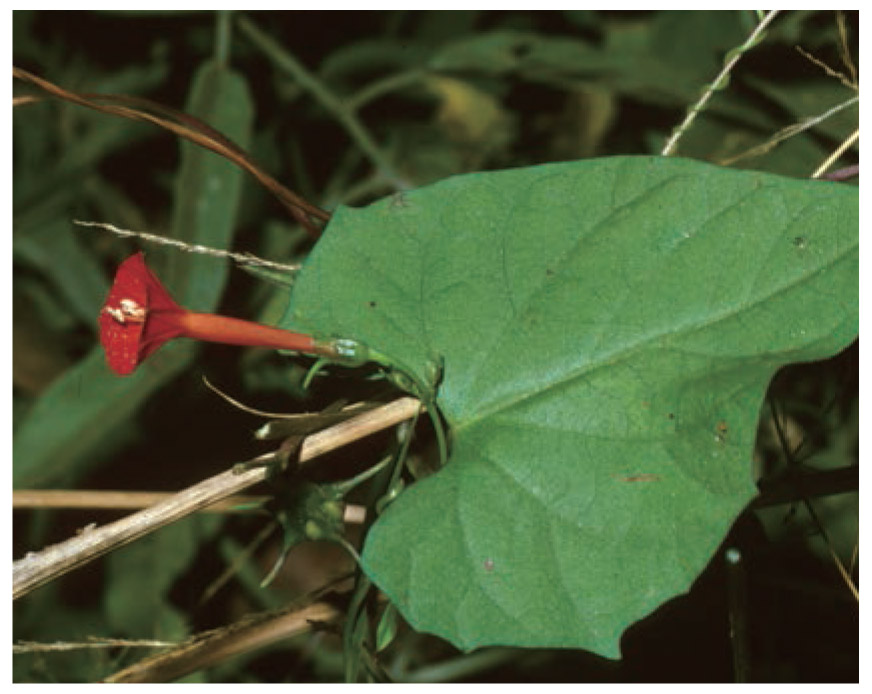
SCARLET CREEPER
Scarlet Morning Glory
Ipomoea cristulata (Ipomoea coccinea)
Morning Glory Family (Convolvulaceae)
Height: Long, twining vine.
Flowers: Bright reddish orange, tubular, and narrow; with white-tipped stamens; to 1” long, ½” wide.
Leaves: Dark green, heart-shaped or 3- to 5-lobed; to 2¼” wide, 2½” long, not including stem.
Blooms: May–October.
Elevation: 2,500 to 6,000’.
Habitat: Canyons, woodlands, hillsides, and along streams.
Comments: Frequented by hummingbirds. Eighteen species of Ipomoea in Arizona. Photograph taken at Clear Creek near Camp Verde, September 30.
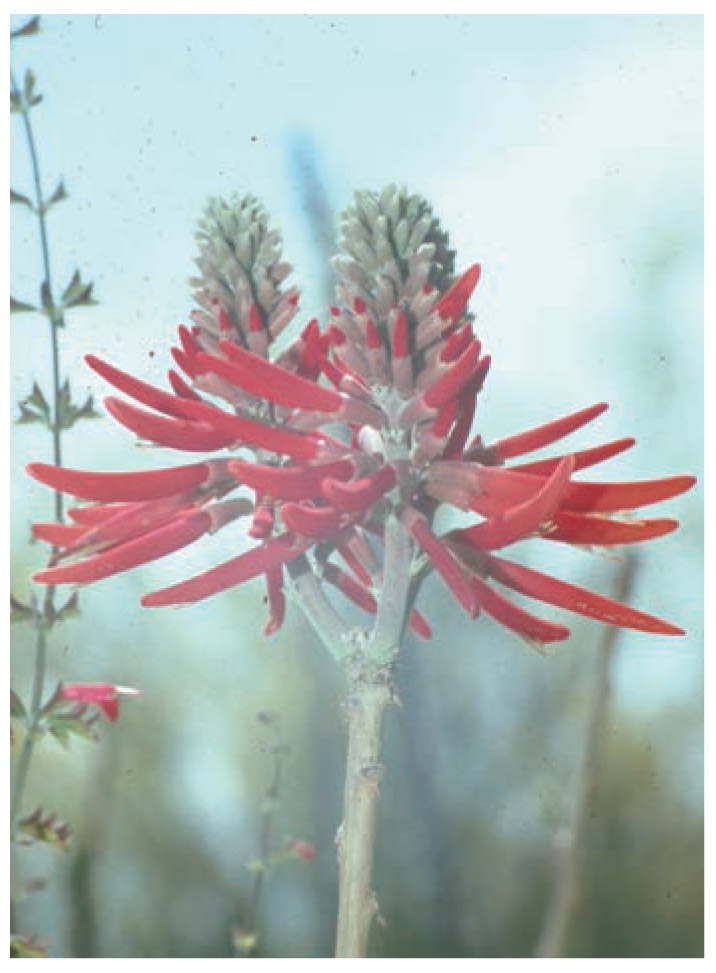
SOUTHWESTERN CORAL BEAN
Chilicote
Erythrina flabelliformis
Pea Family (Fabaceae)
Height: Shrub, or small tree to 15’, usually shorter.
Flowers: Bright red or reddish orange, with whitish, waxy calyx, and long, narrow corolla; pealike; to 3” long, ¼” wide; several in terminal cluster, followed by large, thick-walled pod, to 10” long, ¾” wide; seeds to ½” long.
Leaves: (When present) grayish green, pinnate, with 3 triangular leaflets, each to 3” long, 4” wide.
Blooms: May–July (sometimes in late summer).
Elevation: 3,000 to 5,000’.
Habitat: Dry, rocky hillsides.
Comments: Has short, hooked spines on stems and leafstalks. Flowers appear before leaves. Bright red to brown seeds are very poisonous; used in Mexican jewelry. One species of Erythrina in Arizona. Photograph taken in Tucson area, May 12.
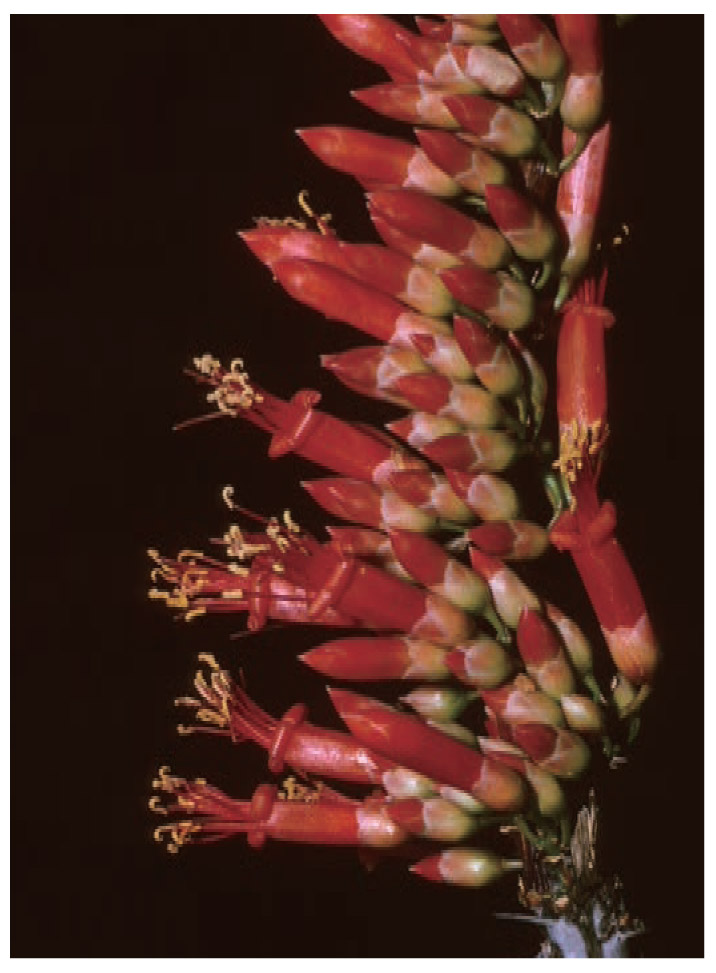
OCOTILLO
Coachwhip
Fouquieria splendens ssp. splendens
Ocotillo Family (Fouquieriaceae)
Height: To 20’ tall.
Flowers: Red, tubular, about 1” long; in clusters to 10” long, at tips of canes.
Leaves: Green, oval, to 2” long.
Blooms: March–June.
Elevation: Below 5,000’.
Habitat: Desert, especially on rocky, well-drained slopes.
Comments: Named for Pierre Fouquier, a French professor of medicine. Relative of the boojum tree of Baja. Despite spines on its stem, the ocotillo is not a cactus. Most of the year its canes are leafless, but after a heavy rain bright green leaves appear on the long stems. When arid conditions return, the leaves change to brown and fall. This drought-responsive process may be repeated several times during the warmer months. Sections of ocotillo planted in rows soon become living fences. Mature plants have up to 75 slender branches. One species of Fouquieria in Arizona. Flower close-up taken at Usery Mountain Recreation Area, March 18.
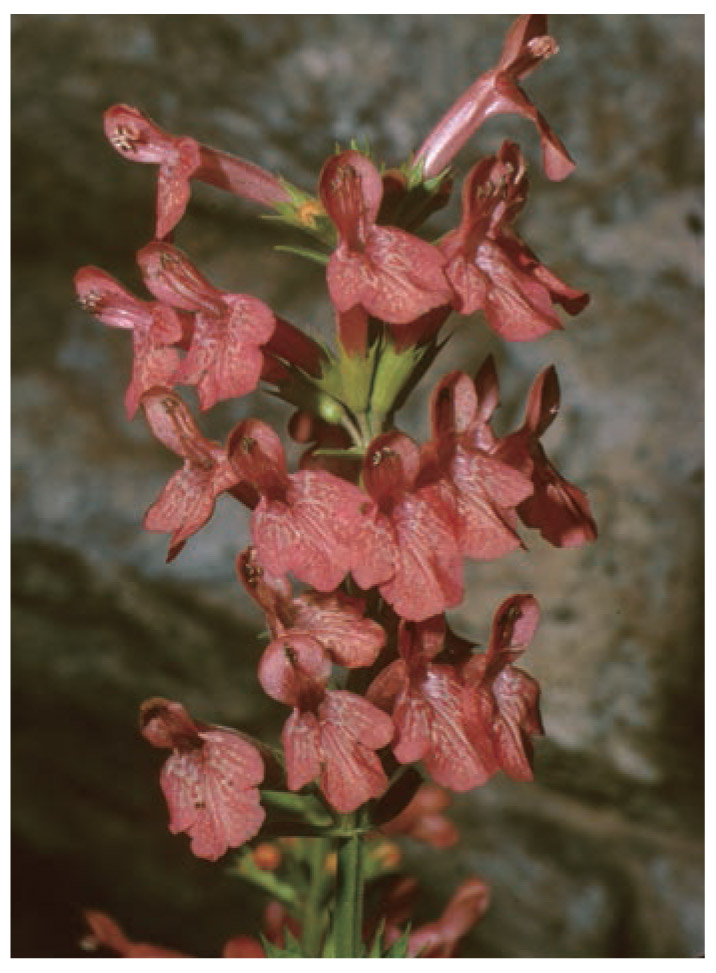
TEXAS BETONY
Scarlet Sage
Stachys coccinea
Mint Family (Lamiaceae)
Height: To 3’.
Flowers: Scarlet, tubular; 2-lipped, with upper lip erect, lower lip 3-lobed and spreading; to 1¼” long; in whorls around stem.
Leaves: Grayish green, oval to triangular, toothed; hairy, with netlike surface; opposite; to 3” long.
Blooms: March–October.
Elevation: 1,500 to 8,000’.
Habitat: Slopes and canyons in rich soil.
Comments: Perennial herb. Square stems. Five species of Stachys in Arizona. Photograph taken below Kitt Peak, April 18.
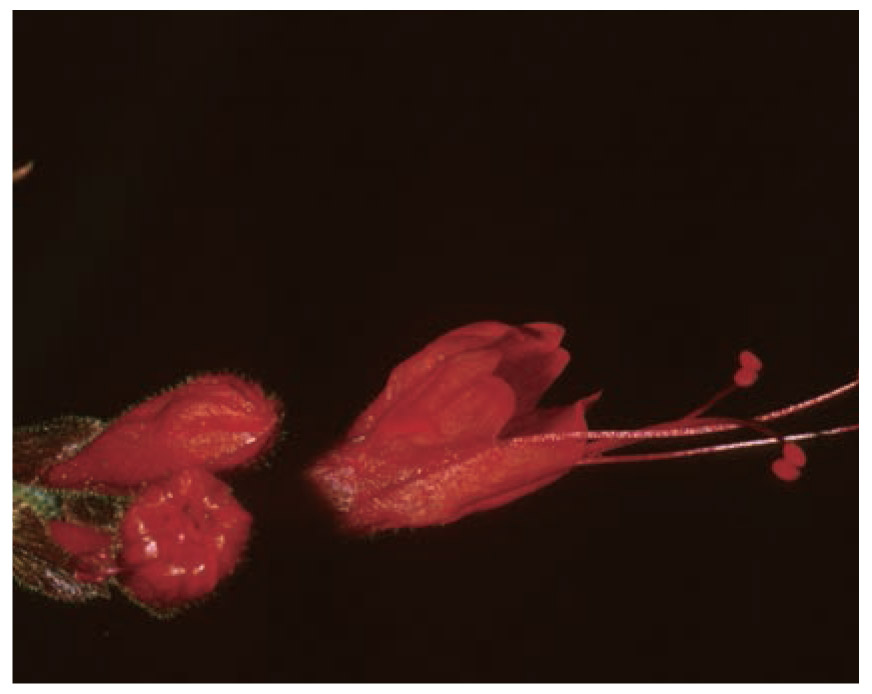
SCARLET FOUR O’CLOCK
Mirabilis coccinea (Oxybaphus coccineus)
Four O’Clock Family (Nyctaginaceae)
Height: To 3½’.
Flowers: Deep carmine-red, tubular, with very long stamens; bright purple on tip of longest stamen; to 1¾” including stamens; in long-stemmed clusters of 3.
Leaves: Grayish green, very narrow, almost threadlike; to 4” long; no basal leaves, few leaves on stalk.
Blooms: May–August.
Elevation: 4,000 to 6,500’.
Habitat: Grassy slopes and clearings in ponderosa pine forests.
Comments: Produces a brilliant flower that opens only at night. Thirteen species of Mirabilis in Arizona. Photograph taken at Lynx Lake, May 27.
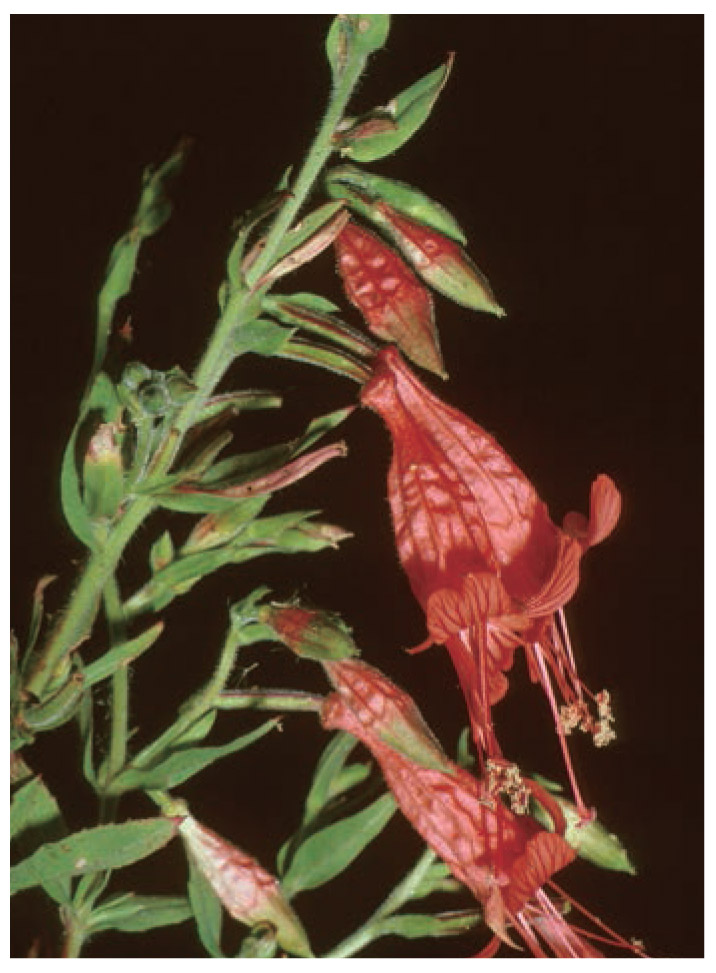
HUMMINGBIRD TRUMPET
Epilobium canum ssp. latifolium (Zauschneria californica ssp. latifolia)
Evening Primrose Family (Onagraceae)
Height: To 2’.
Flowers: Reddish orange, tubular, crinkly, with 4 lobes notched in center; long stamens; to 1½” long, hanging in clusters.
Leaves: Dark green, hairy, narrowly elliptical, toothed; to 1” long, growing all along stems.
Blooms: June–December.
Elevation: 2,500 to 7,000’.
Habitat: Canyons, along washes, and in other damp areas.
Comments: Perennial herb; shredding bark. Thirteen species of Epilobium in Arizona. Photograph taken near Christopher Creek, September 27.
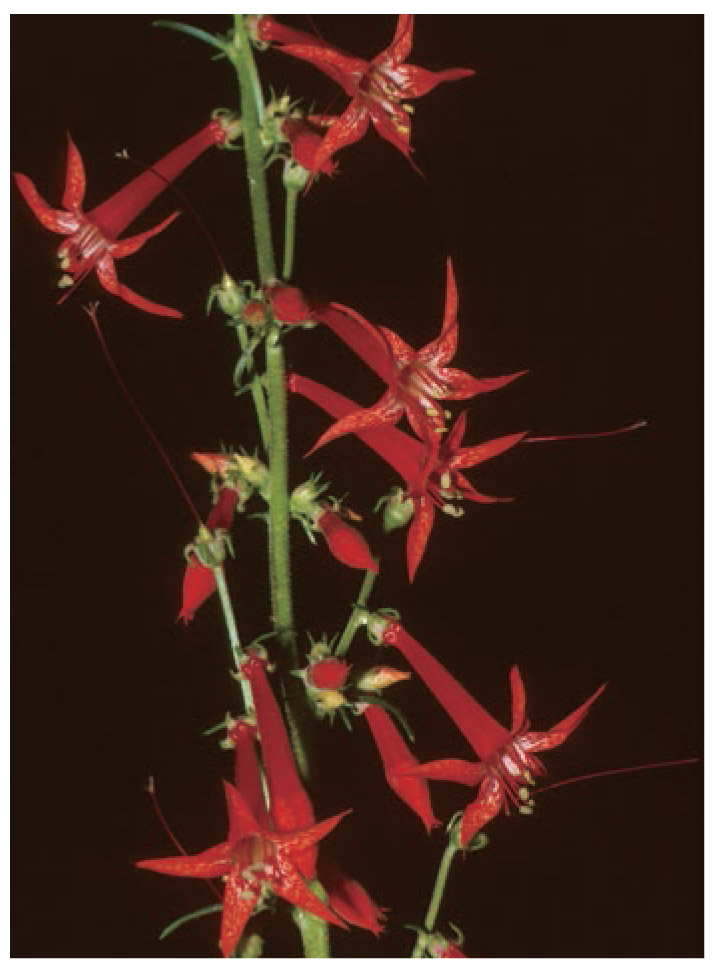
SKYROCKET
Scarlet Gilia
Ipomopsis aggregata (Gilia aggregata)
Phlox Family (Polemoniaceae)
Height: Flowering stem to 3’.
Flowers: Bright red to deep pink, mottled with cream color; funnel-shaped; 5 flaring, pointed lobes; to 1½” long; in leaf axils at tops of nearly leafless stems.
Leaves: Dark green; pinnately divided into very narrow segments; mostly basal; to 2” long.
Blooms: May–September.
Elevation: 5,000 to 9,000’.
Habitat: Roadsides and openings in coniferous forests.
Comments: Biennial; first year, produces rosette of leaves; in the second year, blooms. Has sticky stems; bruised leaves smell skunky. Attracts hummingbirds. Browsed by deer, pronghorn, and livestock. Native Americans used plant medicinally and for ceremonies. Fourteen species of Ipomopsis in Arizona. Photograph taken south of Alpine, July 23.
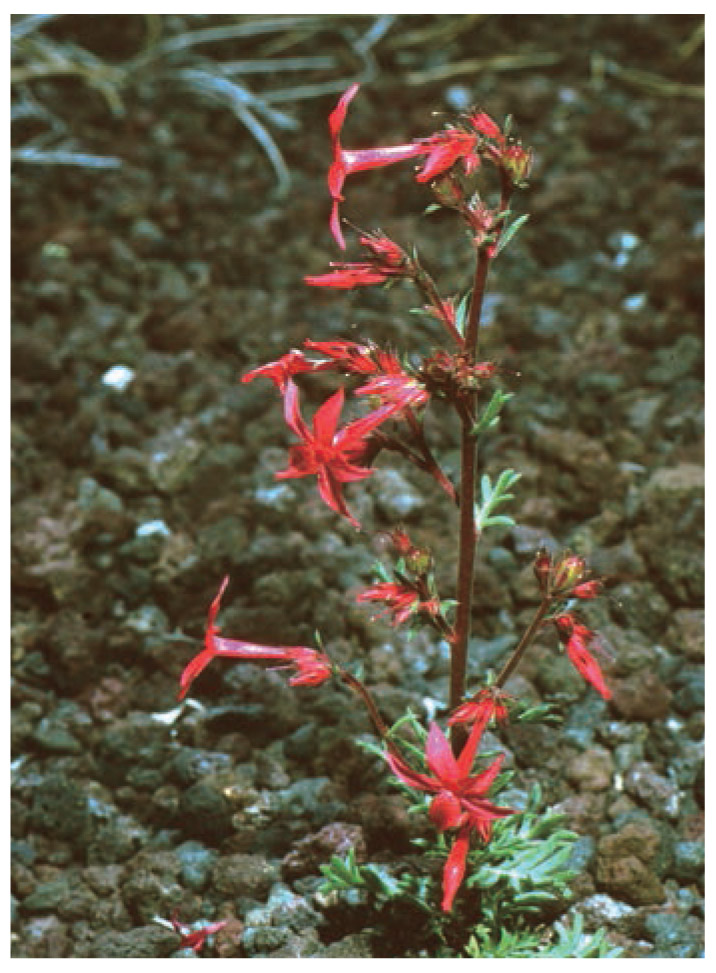
ARIZONA GILIA
Ipomopsis arizonica (Ipomopsis aggregata var. arizonica)
Phlox Family (Polemoniaceae)
Height: Flowering stem to 16” with red stems.
Flowers: Bright red trumpet-shaped flowers to 1” wide and ¾” long; in leaf axils at tops of nearly leafless stems.
Leaves: Dark green and hairy, basal, pinnately divided leaves to 1” long.
Blooms: May–September.
Elevation: 5,000 to 9,000’.
Habitat: Roadsides and openings in coniferous forests. It often grows on volcanic soil.
Comments: Biennial; first year, produces rosette of leaves; in the second year, blooms. Has sticky stems; bruised leaves smell skunky. Attracts hummingbirds. Browsed by deer, pronghorn, and livestock. Native Americans used plant medicinally and for ceremonies. Fourteen species of Ipomopsis in Arizona. Photograph taken at Sunset Crater National Monument, May 31.
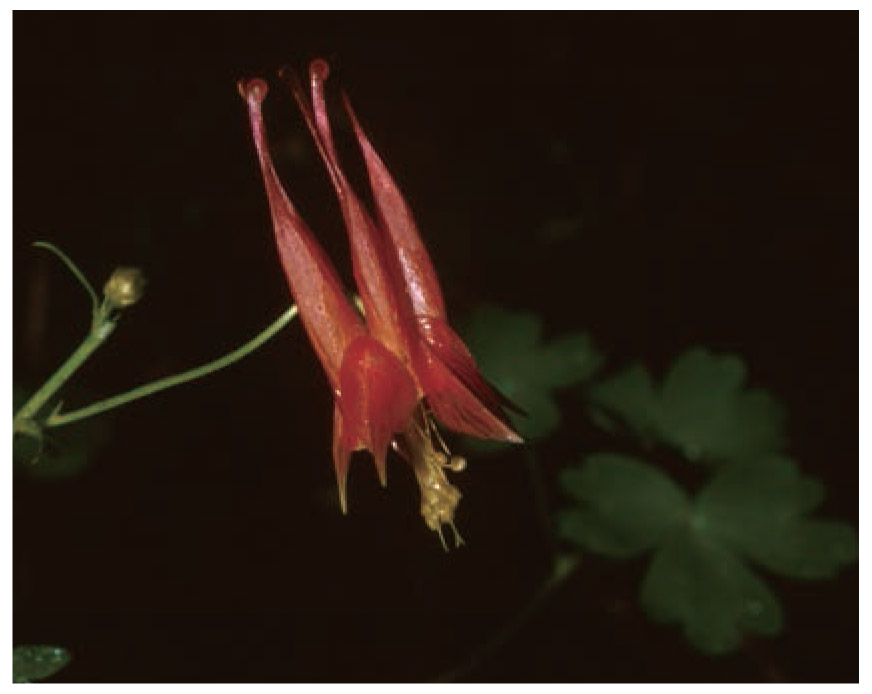
RED COLUMBINE
Aquilegia desertorum (Aquilegia triternata)
Buttercup Family (Ranunculaceae)
Height: To 1’.
Flowers: 5 reddish petals tipped with yellow; long spurs pointing backward; 5 reddish sepals, stamens projecting and nodding; to 1¾” long.
Leaves: Olive-green, divided into threes; leaflets to 1½”.
Blooms: May–October.
Elevation: 4,000 to 10,000’.
Habitat: Moist coniferous forests.
Comments: Perennial herb. Seven species of Aquilegia in Arizona. Photograph taken south of Alpine, August 2.
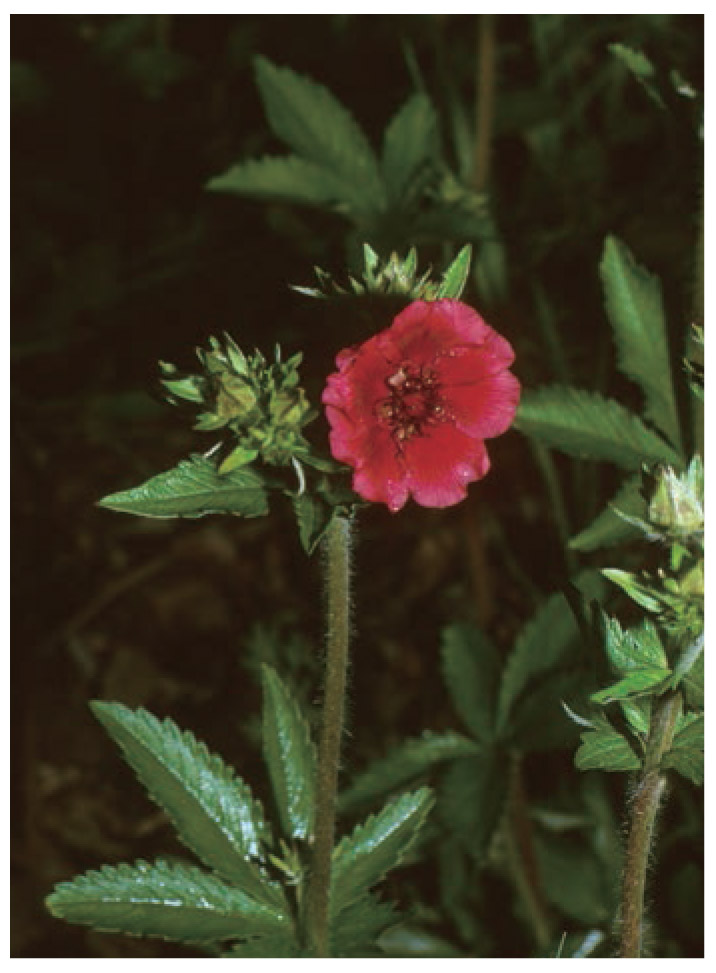
SCARLET CINQUEFOIL
Five-Finger
Potentilla thurberi
Rose Family (Rosaceae)
Height: To 16”.
Flowers: Dark red, with 5 petals; in loose cluster; to 1” wide.
Leaves: Dark green, basal leaves with silky hairs on underside and 5 to 7 finely toothed leaflets, each to 2” long; smaller leaves on stem.
Blooms: July–October.
Elevation: 6,000 to 9,000’.
Habitat: Rich soil in coniferous forests.
Comments: Perennial herb. Twenty species of Potentilla in Arizona. Photograph taken south of Alpine, July 23.
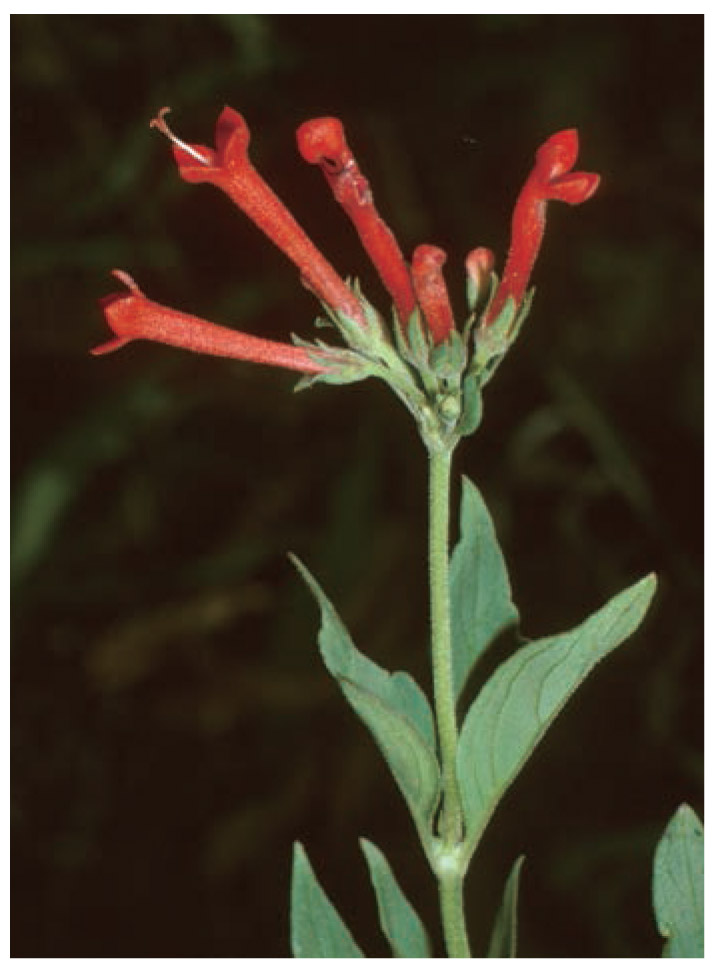
SMOOTH BOUVARDIA
Bouvardia ternifolia (Bouvardia glaberrima)
Madder Family (Rubiaceae)
Height: Small shrub to 3’.
Flowers: Bright reddish orange, narrow, tubular, flaring into 4 lobes; honeysuckle-like; to 1¼” long, ⁵⁄₁₆” wide; in clusters.
Leaves: Dark green, lance-shaped, hairy; generally in whorls of 3, to 3” long.
Blooms: May–October.
Elevation: 3,000 to 9,000’.
Habitat: Slopes and canyons.
Comments: Visited by hummingbirds. Used medicinally in Mexico. One species of Bouvardia in Arizona. Photograph taken at Madera Canyon, May 11.
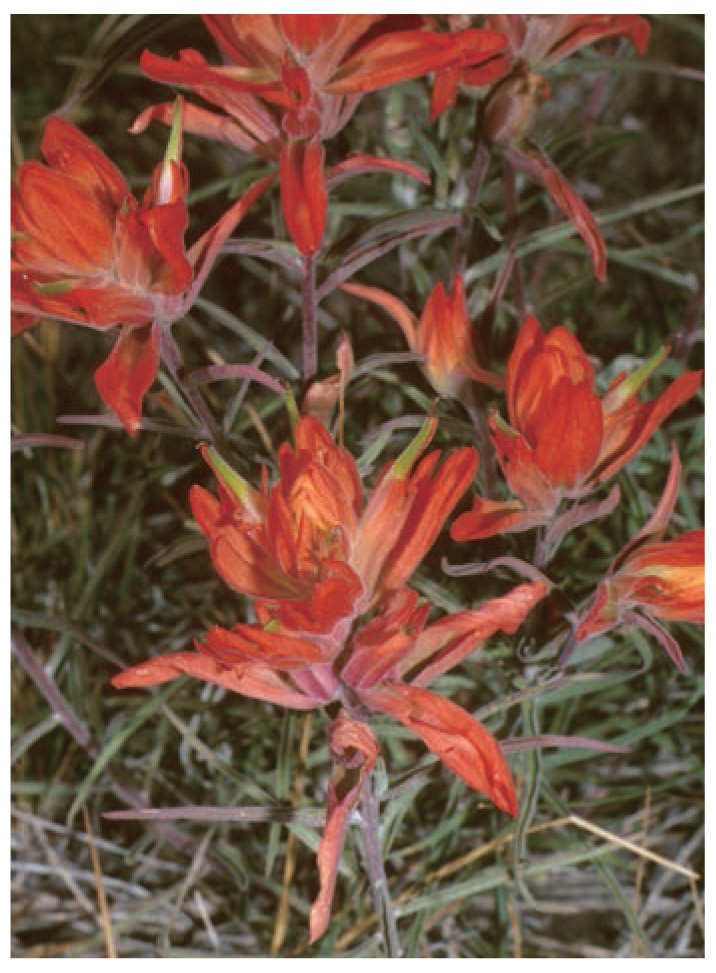
DESERT PAINTBRUSH
Painted-Cup
Castilleja angustifolia (Castilleja chromosa)
Figwort Family (Scrophulariaceae)
Height: To 16”.
Flowers: Reddish or orangish bracts, shorter and wider than leaves; hairy; in terminal cluster. Flowers are inconspicuous and generally hidden within bracts.
Leaves: Reddish green, grayish haired, linear to linear-lobed; to 2” long.
Blooms: March–September.
Elevation: 2,000 to 8,000’.
Habitat: Roadsides, chaparral, and clearings in ponderosa pine forests.
Comments: Removes selenium from soil. Seventeen species of Castilleja in Arizona; the species of this genus are difficult to identify. Photograph taken at Mormon Lake, September 3.
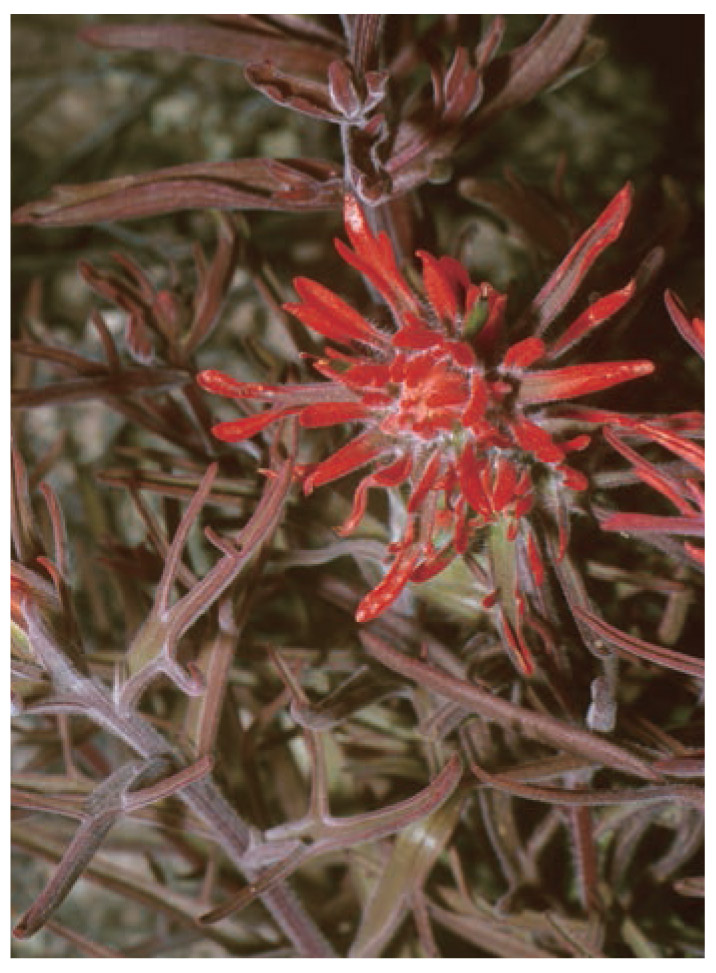
WOOLLY PAINTBRUSH
Painted-Cup
Castilleja lanata ssp. lanata
Figwort Family (Scrophulariaceae)
Height: To 2’.
Flowers: Red to reddish orange, with somewhat narrow bracts, some lobed, very hairy, in terminal cluster. Flowers inconspicuous and generally hidden within bracts.
Leaves: Reddish green, hairy, margins curved upward; to 2” long; linear to linear-lobed; bunches of small leaves in leaf axils.
Blooms: March–August.
Elevation: 2,500 to 7,000’.
Habitat: Arid slopes and desert.
Comments: Seventeen species of Castilleja in Arizona; the species of this genus are difficult to identify. Photograph taken in desert area below Superstition Mountains, March 15.
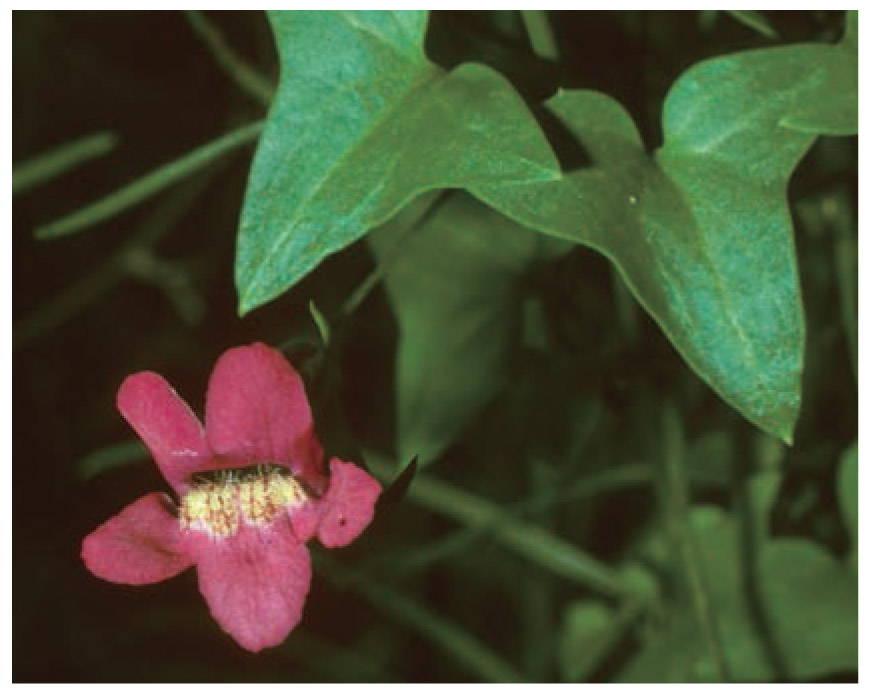
TWINING SNAPDRAGON
Snapdragon Vine
Maurandya antirrhiniflora (Maurandella antirrhiniflora)
Figwort Family (Scrophulariaceae)
Height: Vine; twining over bushes to 8’.
Flowers: Red or purple, snapdragon-like; white in throat with pinkish lines; side lobes flare outward, upper lobes paired and flare upward; to 1” long, ⁵⁄₈” wide.
Leaves: Dark green, arrow-shaped; leathery, strong network; rounded at tip on lower leaves, pointed at tip on younger leaves; to 1¼” wide, 2” long.
Blooms: April–October.
Elevation: 1,500 to 6,000’.
Habitat: Among shrubs in washes, on rocky slopes, and in pinyon-juniper woodlands.
Comments: Perennial herb. Stems of flowers and leaves twist in all directions. Three species of Maurandya in Arizona. Photograph taken at Dead Horse Ranch State Park, May 30.
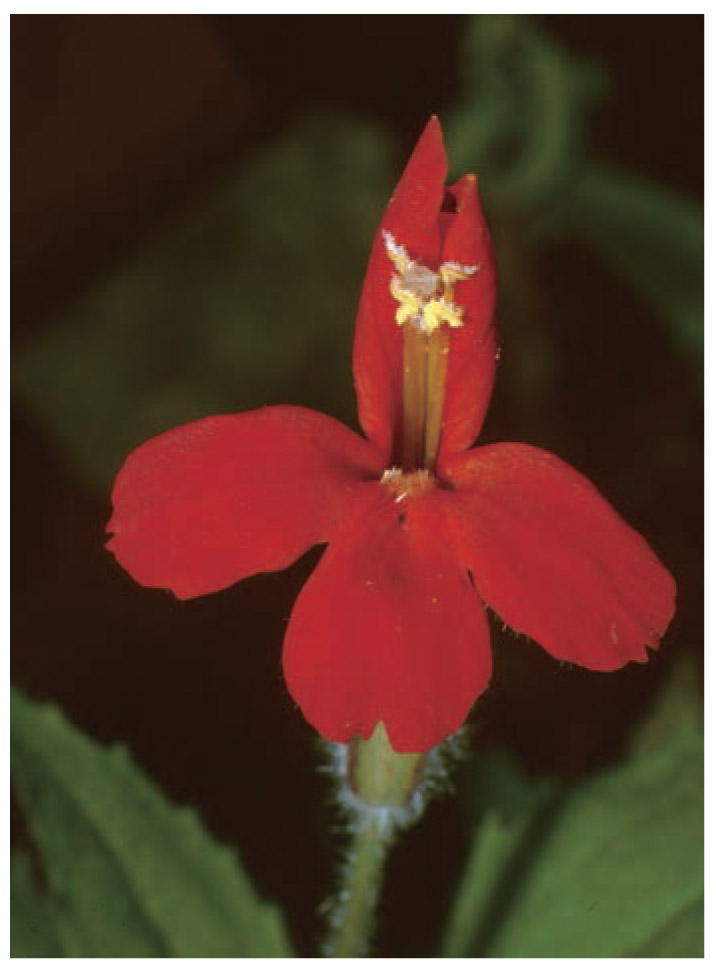
CRIMSON MONKEY FLOWER
Scarlet Monkey Flower
Mimulus cardinalis
Figwort Family (Scrophulariaceae)
Height: To 3’.
Flowers: Crimson red to reddish orange, tubular; 2-lipped, with 3 lobes of lower lip notched, upper lip arched upward; yellow stamens, hairy sepals; to 2” long, 1” wide; terminal, on 2”-long stem.
Leaves: Dark green, hairy, opposite; oblong to oval, coarsely toothed, sticky; clasping stem; to 4¼” long.
Blooms: March–October.
Elevation: 1,800 to 8,000’.
Habitat: Seeps, springs, along flowing streams, and in wet canyons.
Comments: Stems hairy. Fourteen species of Mimulus in Arizona. Photograph taken along West Fork of Oak Creek Canyon, October 1.
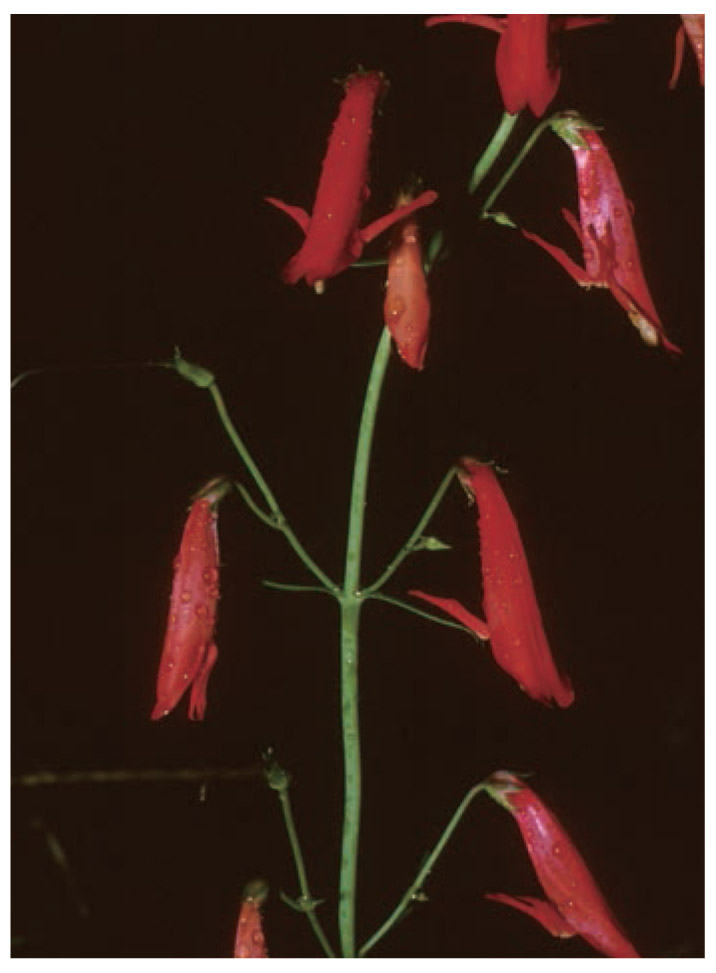
GOLDEN-BEARD PENSTEMON
Beardlip Penstemon
Penstemon barbatus
Figwort Family (Scrophulariaceae)
Height: To 4’.
Flowers: Scarlet red, narrow, and tubular; with upper lip projecting forward, lower lip bent downward with sides flared backward; to 1½” long; in open, terminal raceme mostly on one side of stem.
Leaves: Gray-green, narrow, smooth; to 5” long.
Blooms: June–October.
Elevation: 4,000 to 10,000’.
Habitat: Roadsides, oak woods, and coniferous forests.
Comments: Native Americans use plant for medicinal and ceremonial purposes. Pollinated by hummingbirds. More than three dozen species of Penstemon in Arizona. Photograph taken south of Alpine, August 2.
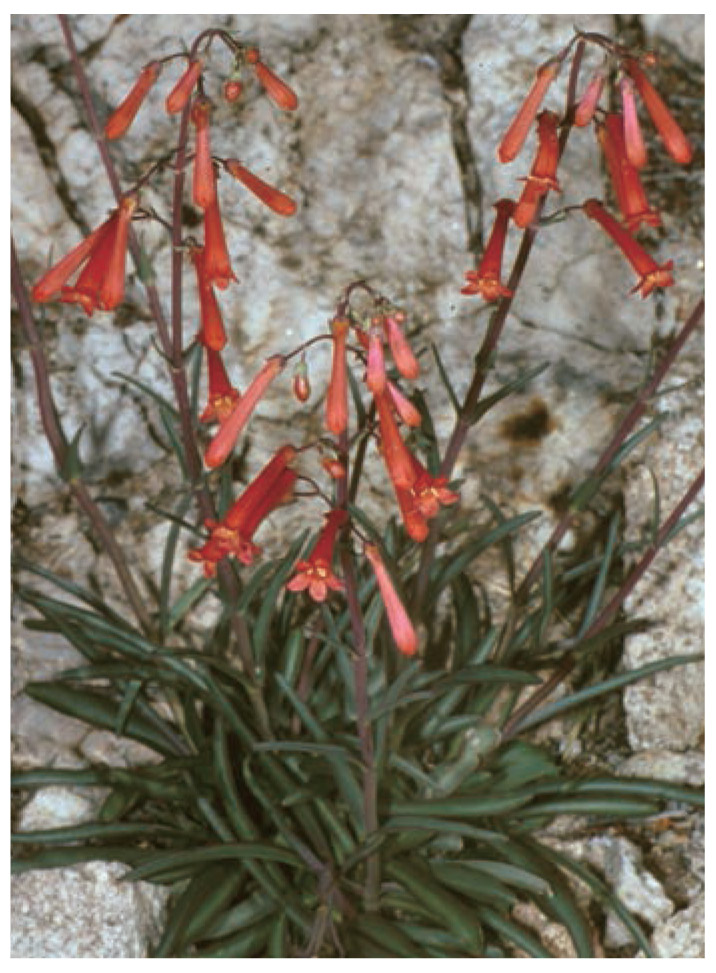
FIRECRACKER PENSTEMON
Penstemon eatonii
Figwort Family (Scrophulariaceae)
Height: Flower stalk to 2’.
Flowers: Bright scarlet red, tubular, with width of tube fixed; flaring lobes about equal; to 1” long; in elongated cluster.
Leaves: Dark green, leathery, mainly basal; to 2½” long.
Blooms: February–June.
Elevation: 2,000 to 7,000’.
Habitat: Roadsides, desert slopes, and mesas.
Comments: Stems are purplish. Several subspecies. More than three dozen species of Penstemon in Arizona. Photograph taken in Alamo Lake area, February 27. P. eatonii is similar to Scarlet Bugler (Penstemon subulatus) (page 238), but its tubes are shorter.
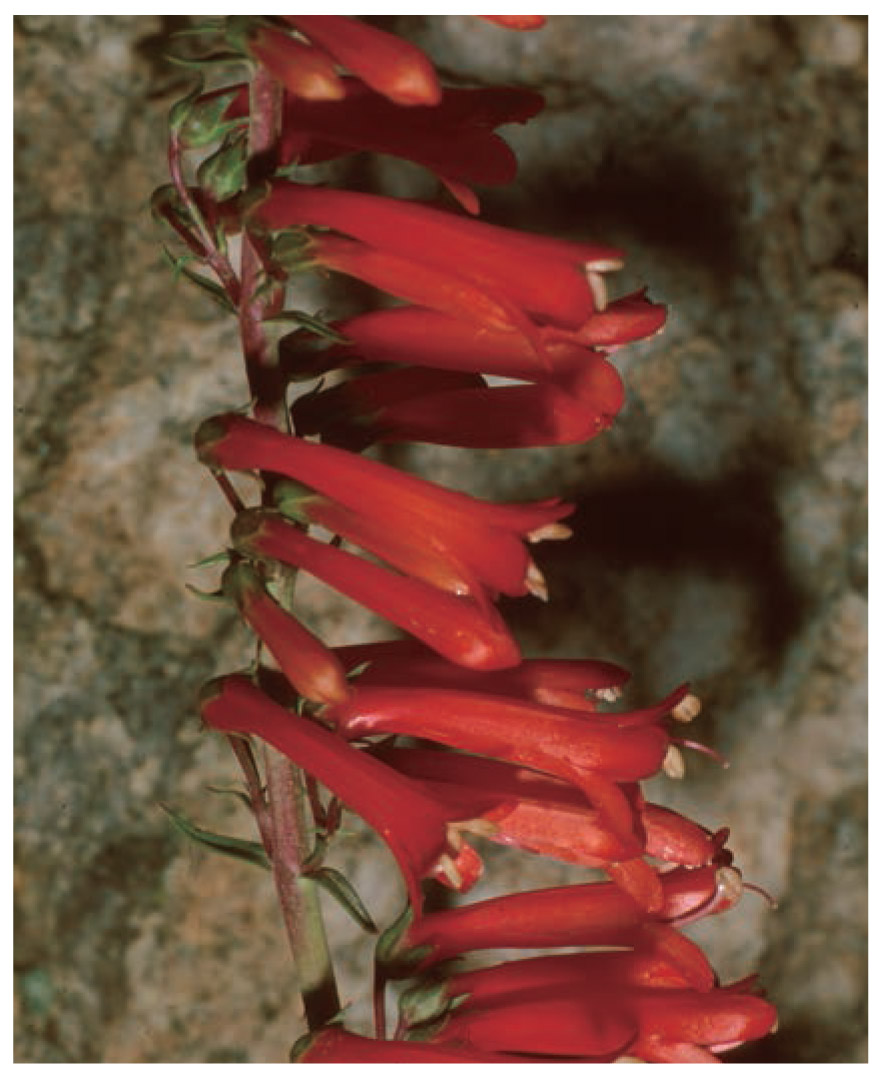
SCARLET BUGLER
Penstemon subulatus
Figwort Family (Scrophulariaceae)
Height: To 3’.
Flowers: Bright red, tubular, with 5 short lobes rounded at tips; to 1¼” long; on one side all along upper stems.
Leaves: Dark green, smooth, thick; lance-shaped to spatula-shaped, opposite; to 3” long.
Blooms: March–June.
Elevation: 600 to 4,500’.
Habitat: Dry hillsides and cliffs.
Comments: Stem is pinkish. More than three dozen species of Penstemon in Arizona. Photograph taken near Apache Lake, March 29.